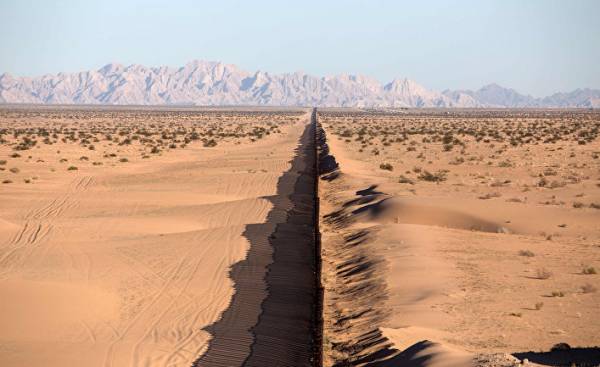
In the US, currently estimated there are about 11.7 million Mexican immigrants, as legally and without permission. This is 28% of the total number of immigrants living in the country (about 42 million people). No doubt, Mexicans represent a significant part of the total mass of the immigrants.
Since 2007, migration from Mexico to the United States annually was approximately 200 thousand people, far below the average of 90-ies, which amounted to 466 thousand people a year. In a recent research report of the Pew Hispanic center (2012) indicates that, since 2011, the number of Mexicans born in the United States began to decline. This, in turn, indicates that in recent years the net inflow of immigrants would become negative. That is now more and more Mexicans can move from the US to Mexico than from Mexico to the United States.
In fact, Mexicans don’t represent a major flow of migration, arriving in the United States. Since 2013, China and India topped the list of countries whose citizens were in the United States as immigrants during the year or less.
It is in this atmosphere that Donald trump made their statements and took the first steps in the direction of unfriendly immigration policy, primarily affecting immigrants from Mexico. In may 2015, during the so-called “Summit in the name of freedom”, held in South Carolina, trump angrily said: “Mexico will no longer live at our expense. We have with them will be no more open borders. The largest Builder in the world is me and I will build the biggest wall they’ve ever seen. And guess who will pay for the construction of: Mexico.” January 25, press Secretary of the White house Sean Spicer (Sean Spicer) reported that trump has signed the decree about the beginning of the construction of a wall on the border with Mexico.
Ideas or beliefs underlying the aggressive migration policy trump against Mexico, is simple and has long been very common among the American public. First it is noted that Mexican immigrants take jobs in the United States, increasing unemployment among American workers, especially in manufacturing.
Secondly, it is indicated that workers of Mexican origin, with extremely low skills, and accept low-paid jobs, causing, thus, lower wages to local workers. Thirdly, it is argued that these immigrants create an additional burden for the Federal government and American taxpayers, since actively using the services of the US healthcare system. Eventually, immigrants of Mexican origin accused of involvement in criminal activities and the deterioration of a criminogenic situation in the country.
Over the last two decades, economists have shown increasing interest in migration activity with the United States, and in many scientific works deals with the impact of immigration on the wage structure, employment, crime and government social programs. All and each of the representations, which are based on the position, attitudes and anti-immigration policies of Donald trump and his advisers, in the end, contradicted by these studies.
For example, research on the impact of Mexican immigrants on the wage structure of low-skilled workers born in the United States began a little over a decade ago with the work of card (Card) and Lewis (Lewis) (2005) and Toussaint-Comeau (Toussaint-Comeau) (2007). Using census data 1980, 1990 and 2000, as well as the econometric model, both the scientific work reject the hypothesis that the arrival of low-skilled Mexican immigrants reduces the wages of American workers. Even more convincing is the evidence presented Chalfin (Chalfin) and Levi (Levy) (2013). In their study, both authors have managed to rise above the econometric models used in assessing migration from some cities of Mexico, in some U.S. cities. Calvin and Levi did not find any significant impact of the arrival of immigrants (research was conducted in 76 major cities) on wages of local workers. These results were confirmed in different age, ethnic and racial groups and in groups with different levels of professional qualification.
Studies the impact of entry of Mexican immigrants on the employment of local workers, refute another myth. In 2003 the U.S. Commission on international trade (USITC)5/ have developed sophisticated General equilibrium model in order to assess the economic effects of various free trade agreements signed by the United States. Among other things, the experts USITC found that from 1994 to 2000, the United States could get an additional 270 jobs thanks to the free trade agreement with Mexico and Canada (NAFTA.
Ten years later, in 2013, Calvin and Levi found that the presence of labour migrants of Mexican origin in General has no effect on the unemployment rate of workers born in the United States. Moreover, it has a positive effect on the employment of qualified local workers. In a recent study conducted by Brian Cadenas (Brian Cadena) from the University of Colorado and Brian Kovacs of Carnegie — Mellon (Cadena y Kovac 2013) are even more amazing facts. For example, the fact that low-skilled Mexican workers immigrant labor are much more prone to change jobs than workers born in the US, so that in times of recession the latter there are more opportunities for employment. This may be due to the fact that labour immigrants usually are not protected by unemployment insurance, with the consequence that their existence depends solely on wages. Thus, after the recent recession, Mexican immigrants are much more willing to move than others, thereby contributing to the alignment of the labour market.
With regard to allegations of Mexican labor immigrants adversely affect the employment in the manufacturing industry (this thesis is periodically repeated trump and his supporters), it is enough to indicate that only Mexican immigrants account for only 6% of total employment in the U.S. manufacturing industry. Mexicans are mostly engaged in agriculture (27%) and construction industry (15%).
The health system is also not experiencing any pressure from Mexican immigrants. Data collected by the Product (Tovar) along with other authors (2014) indicate that for every thousand children born in Mexico under the age of 18 have 120 people that do not have a U.S. insurance policy, while among Americans the figure is 10 people for every thousand. Despite the fact that immigrants from Mexico account for only 4% of the population, health insurance policies do not have 13%.
In the United States, indeed, there are about 6.4 million natives of Mexico who have no health insurance. More than half of Mexican labor immigrants. Lack of health insurance is particularly pronounced among immigrants working in agriculture (71%), construction (69%) and in low-paying jobs (63%), where especially large number of accidents and diseases. According to a study conducted recently by the University of California at Berkeley in cooperation with the Ministry of internal Affairs of Mexico, Mexicans are the least use the US health care system. In this case, Mexican migrant workers could hamper the work of the American health care if they use it very little?
Especially quickly dispelled the myths, if we analyze the problem of crime. For anybody not a secret that the level of crime in the United States in recent years has declined. Moreover, it is significantly more decreased in the United States, where the rise of immigration flows.
In accordance with the data on crime provided by the FBI, among cities with population over 500 thousand people the lowest level of crime recorded in San Diego, Phoenix, El Paso and Austin. All of them are on the border with Mexico, and are home to a significant number of Mexican immigrants. Here especially it is important to refer to the study of Aaron Chalfin (2014)9/ reviewing empirical findings on the impact of Mexican immigration on crime. Calvin concludes that the vast majority of empirical studies, conducted since 1998, do not reveal any connection between Mexican immigrants and criminal situation. The study itself Calpine confirms these results, based on annual, not averaged data over the decades.
It is obvious that a President trump and his advisors in the field of migration exploit stereotypes based not only on vague and inadequate views, but frankly false promises. Will public policy trump against Mexican immigrants in case of exposing of these false promises? Apparently, no. But in any case it is useful to know the truth.







